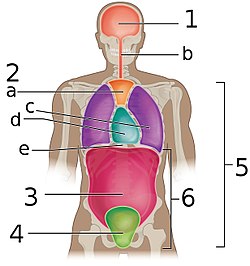Pleural cavities
| Pleural cavity | |
|---|---|

The pleural cavity, shown in purple
|
|
| Details | |
| Precursor | intraembryonic coelom |
| Identifiers | |
| Latin | cavum pleurae, cavum pleurale, cavitas pleuralis |
| MeSH | D035422 |
| TA | A07.1.01.001 |
| TH | H3.05.03.0.00013 |
| FMA | 9740 |
|
Anatomical terminology
[]
|
|
The pleural cavity is the thin fluid-filled space between the two pulmonary pleurae (known as visceral and parietal) of each lung. A pleura is a serous membrane which folds back onto itself to form a two-layered membranous pleural sac. The outer pleura (parietal pleura) is attached to the chest wall, but is separated from it by the endothoracic fascia. The inner pleura (visceral pleura) covers the lungs and adjoining structures, including blood vessels, bronchi and nerves. The pleural cavity can be viewed as a potential space because the two pleurae adhere to each other (through the thin film of serous liquid) under all normal conditions.
In humans, there is no anatomical connection between the left and right pleural cavities. Therefore, in cases of pneumothorax, the other lung will still function normally unless there is a tension pneumothorax or simultaneous bilateral pneumothorax, which may collapse the contralateral parenchyma, blood vessels and bronchi.
The visceral pleura receives its blood supply from the bronchial circulation, which also supplies the lungs. The parietal pleura receives its blood supply from the intercostal arteries, which also supply the overlying body wall.
The costal and cervical portions and the periphery of the diaphragmatic portion of the parietal pleurae are innervated by the intercostal nerves. The mediastinal and central portions of the diaphragmatic pleurae are innervated by the phrenic nerves. The visceral pleurae covering the lung itself receive their innervation from the autonomic nervous system and have no sensory innervation. Only the parietal pleurae are sensitive to pain.
...
Wikipedia
